Portugal - A country full of wonders!
From the shores of the Atlantic to its wild hinterland, Portugal is a popular European destination with countless assets: magnificent landscapes, idyllic beaches and delicious cuisine! As a country of fishermen and explorers, Portugal will never cease to surprise you. An ideal destination all year round (300 sunny days per year) thanks to its mild and sunny climate, Portugal is also accessible for all budgets. Culture enthusiasts, sports enthusiasts and foodies will undoubtedly love the country. For a memorable stay, you can choose from many different activities: cruises along the coast, nature hikes and visits to mediaeval villages. Among the charms of the country is Portugal’s unique hospitality. Islam has a long history in the Iberian Peninsula, traces of which are still visible today in the many attractions that inspire Muslim tourists to visit Portugal.
Portugal's Islamic heritage
During the 8th century, Portugal, together with Spain, was part of the prosperous region, known in Arabic as Al-Andalus, ruled by the expanding Umayyad Empire. It was a golden age of the arts and sciences and of architecture. From 711 for around five centuries the region was under Muslim rule and research has shown that by the 10th century around half of the population of the Iberian Peninsula was Muslim. In 1249, Faro on Portugal’s Algarve coast, was the last Muslim stronghold to be captured by King Afonso III and in 1496, all remaining Muslims, together with the Jewish population, were expelled.
In recent years there have been some attempts to revive Portugal’s lost Islamic history and give it its rightful place in history. For example, an interesting project by the Portuguese writer Adalberto Alves was the publication of a dictionary listing over 19,000 Portuguese words and expressions which have Arabic origins.
As you travel the country, you will see hints of Portugal’s rich Islamic legacy everywhere in its buildings and architecture. Discover our selection of 4 authentic places to visit in Portugal whether you’re looking for a weekend break or a longer trip.
1. Lisbon: the trendiest European capital
Lisbon, also called the “City of Seven Hills,” was largely built on several hills overlooking the Tagus River. This beautiful city in the splendour of the Atlantic is known for its unique historic centre, stunning architecture, idyllic scenery, hospitality, colourful azulejos, fascinating history and fantastic cuisine. Lisbon was an important commercial centre and the city has retained its charm while adapting to modern life.
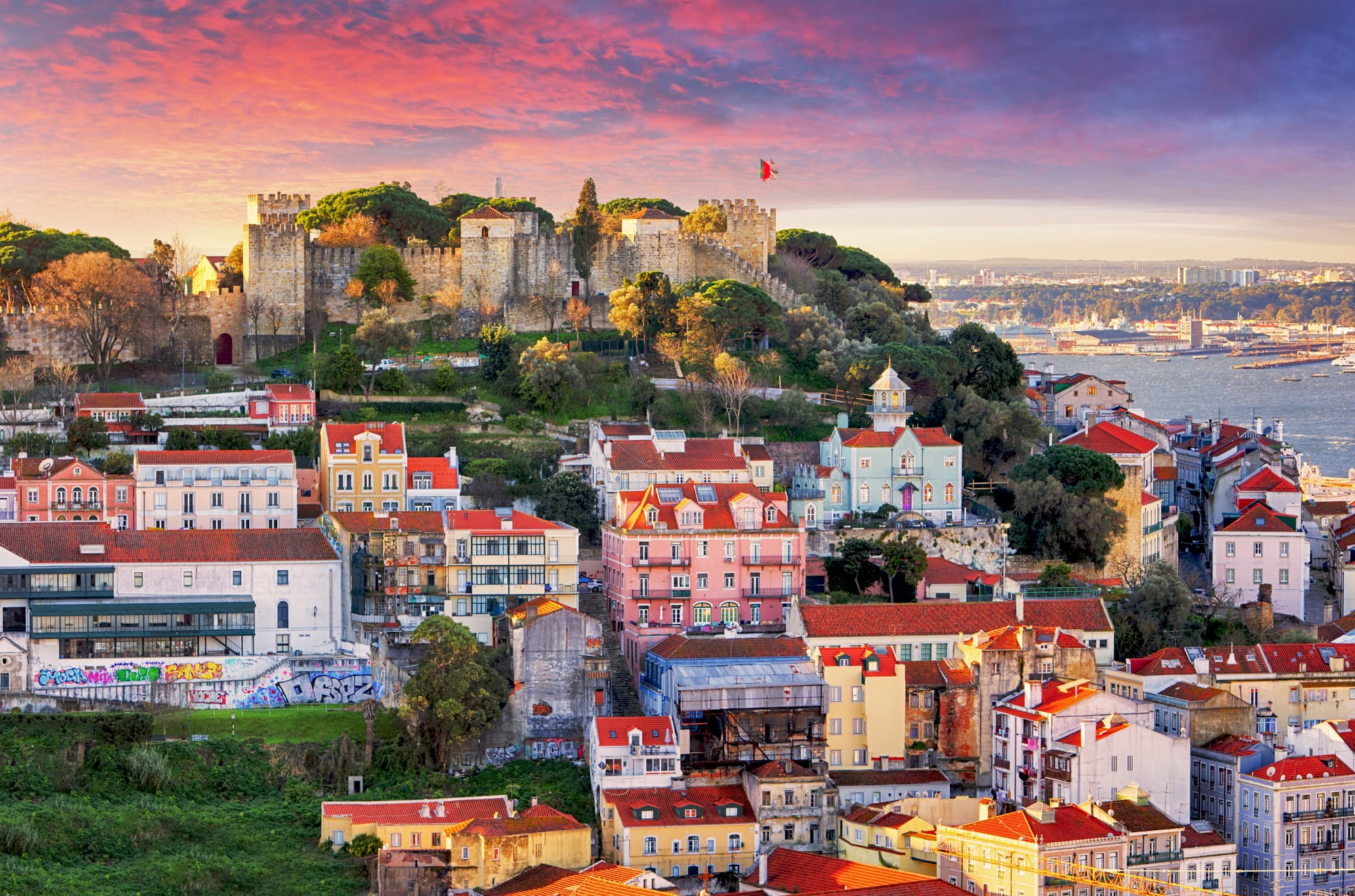
Top attractions in Lisbon
- São Jorge Castle - This historic castle in the heart of Lisbon offers unrivalled, breathtaking views of the city. Formerly a fortress, it was built by the Moors in the 11th Century when much of the Iberian Peninsula was under Muslim rule. Though much has changed, thanks to major restoration work made in the 1940’s, there is still lots to see with its watchtowers, gardens and courtyards.
- Belém Tower - Belem Tower is one of Lisbon’s top attractions and has the distinction of being a UNESCO World Heritage Site. Built during the Age of Discovery in the early 16th century, it was originally a defence tower built by the Moors and later became an essential entry and exit point for Portuguese explorers, given how close it is to the Atlantic Ocean.

- Calouste Gulbenkian Museum - Calouste Gulbenkian collated this vast collection of Islamic art during his travels. It spans various regions, including ancient Persia, Türkiye, Syria, Central Asia and Egypt with artefacts dating from the 12th to 18th centuries - a must-see for any Muslim visitor.
- Jeronimos Monastery - This is another UNESCO World Heritage Site which was given its status in 1983. It was built in the 16th century by King Manuel I in the Belem area of the city. Today it is recognised as one of Portugal’s most important and unique pieces of architecture.
- Rossio Square - A bustling square located in the heart of downtown Lisbon that was built in 1848. It features the famous wave-patterned sidewalk that is also found in other Portuguese-speaking countries such as Macau, Brazil and Cape Verde.
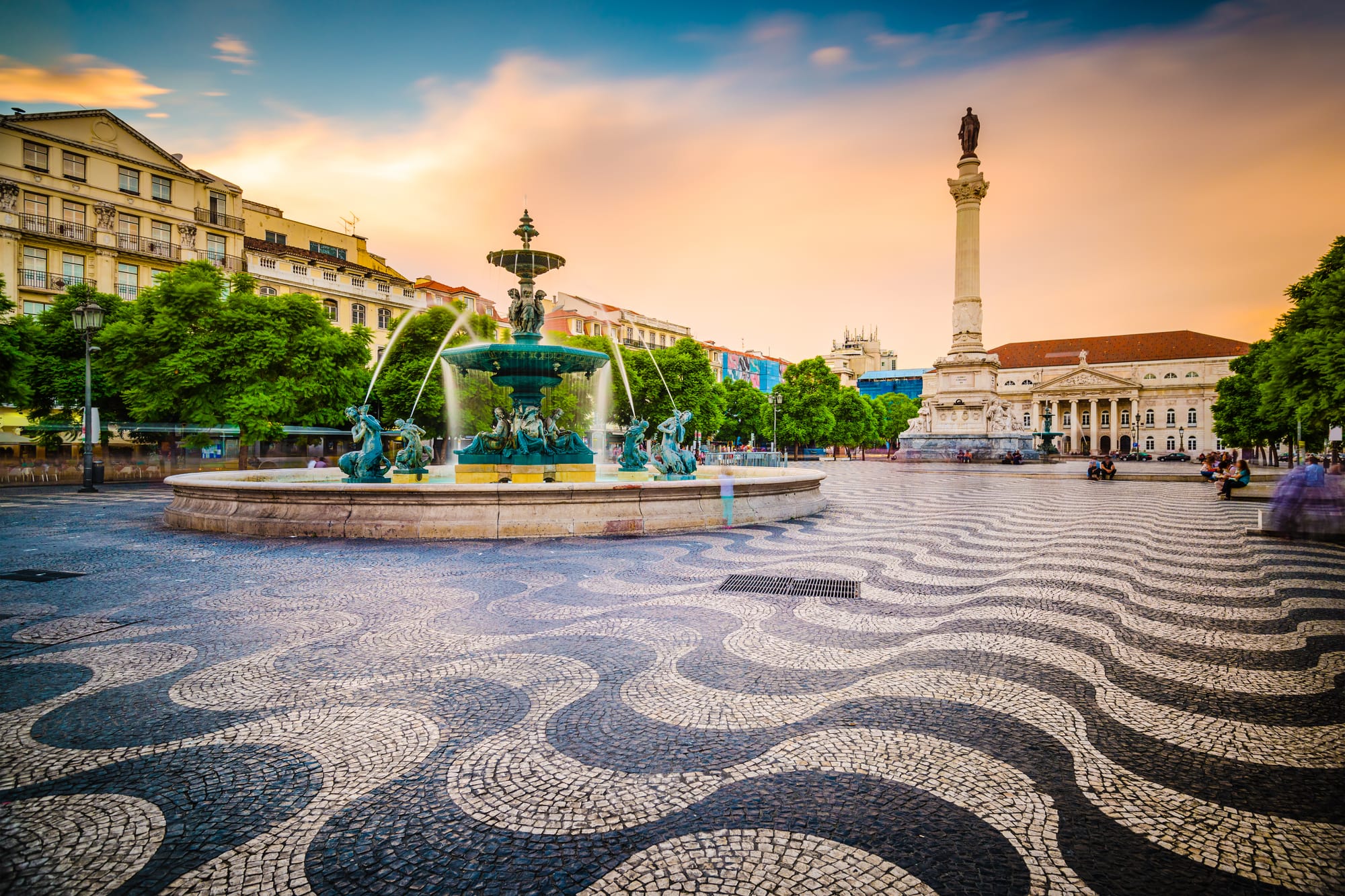
- Historic districts - To appreciate the authenticity of Lisbon, stroll through the historic districts. The Alfama district, known as the ‘Moorish quarter’, is the oldest in Lisbon. Its narrow cobbled streets lead up to the Sao Jorge Church via a steep hill from the banks of the Rio Tejo river, where you can enjoy panoramic views of Lisbon from the top. Check out quirky flowered balconies, boutique shops, cafes and restaurants in its many side streets and alleyways. Let yourself be carried away by the rhythm of fado, a Portuguese musical genre expressing melancholy through popular chants, usually accompanied by instruments like the mandolin and acoustic guitar, and stop in one of the ancient taverns to taste fresh grilled fish. Bairro Alto is another neighbourhood appreciated for its two faces: quiet during the day and lively at night. The restaurants, bookshops and bars offer an exceptional panoramic view over the centre of Lisbon. Gourmets may wish to stop off in the Belém district to taste the typical local pastry: Pasteis de Nata (custard tarts).
- Sintra - Previously an Arab town under Muslim rule and sometimes actually known as ‘Arab Town’, Sintra is a town 30 km from Lisbon, which can be reached by a short train or car journey. Surrounded by pine forests, it showcases its Islamic heritage and architecture in its villas, palaces and castles. Some of the main Islamic attractions of Sintra are the Monserrate Palace, which was built in the 19th century and is known for its Islamic-inspired architecture. It features a blend of Gothic, Indian, and Moorish styles, with intricate tilework and ornate ceilings. The Seteais Palace was built in the 18th century and features a mix of Gothic, Neoclassical, and Moorish styles. The palace has beautiful gardens and offers stunning views of the Sintra Mountains. The Sintra National Palace was built in the 14th century and used by Portuguese royalty as a summer residence. It has a mix of Gothic and Islamic styles, with intricate tilework and painted ceilings. The Castelo dos Mouros (translated as ‘the castle of Moors’) was built in the 10th century by the Muslims who had settled here in the Iberian Peninsula, as a lookout and defence post to protect the surrounding territories, as well as maritime access to the city of Lisbon.
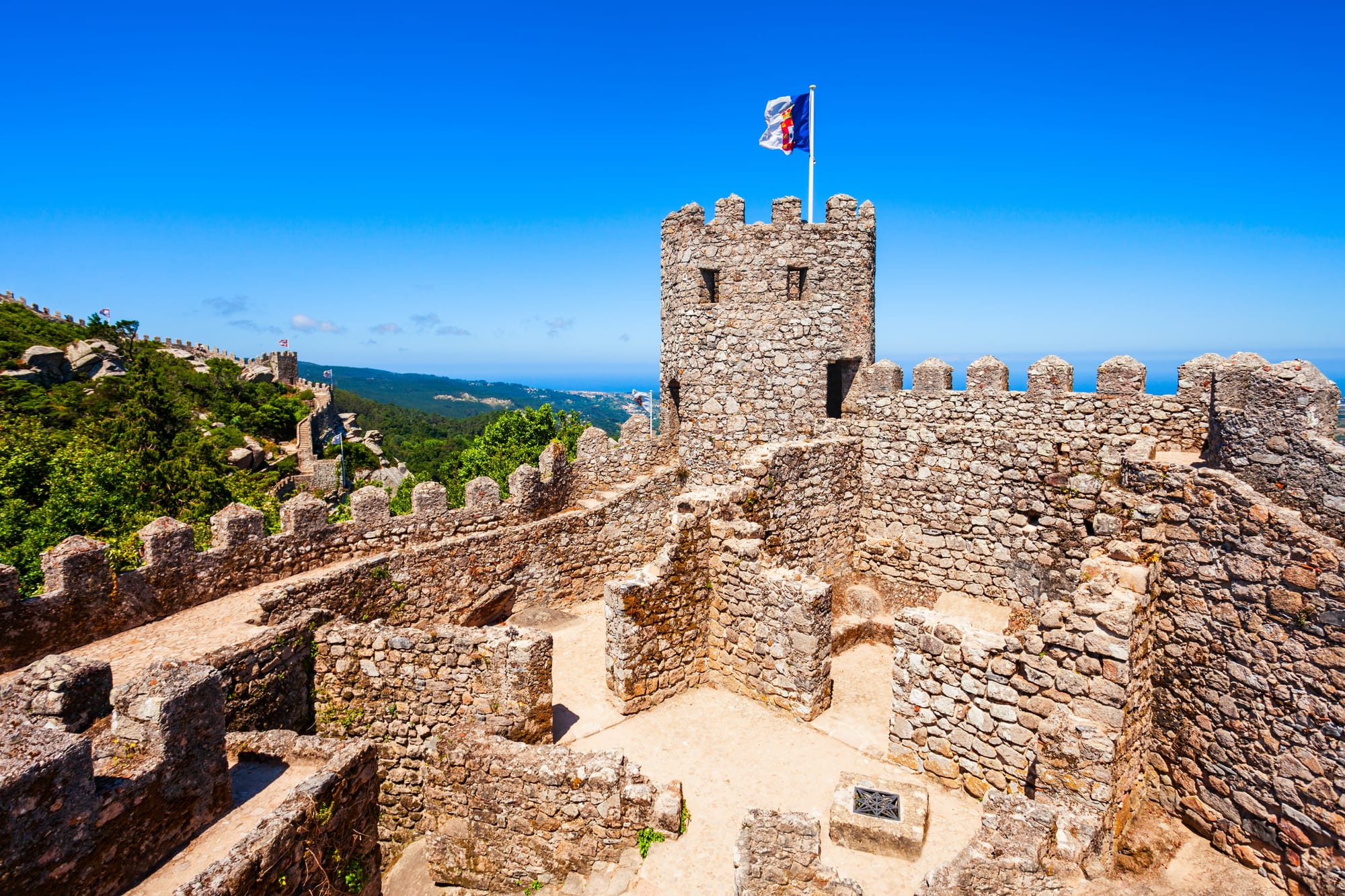
Mosques in Lisbon
Because of Lisbon has a’s growing Muslim community, which means that there are a number of mosques that you can visit during your stay and pray at while on your visit. In all there are approximately 54 mosques in Portugal, with most of them situated in Lisbon.
- Central Mosque of Lisbon - This is Lisbon’s largest mosque, and the third largest in Europe. Naturally, it is the most visited in the city and can be found in the Martim Moniz area. Built in 2019 by award-winning architects, it has four minarets and two domes.
- Mosque of the Islamic Community of Lisbon - Another focal point of the Muslim community, which can be found in the Alvalade area of Lisbon.
- Mosque of the Islamic Community of Odivelas - A large and spacious mosque in the Odivelas area of Lisbon, where much of the Muslim community congregates for prayers. Odivelas is also home to one of the largest Muslim populations in Portugal and, therefore, a popular choice with locals.
- Martim Moniz Mosque - A popular community mosque in a lively area of Lisbon - get there early for Jumu'ah as this small and cosy mosque can get busy on Fridays!
Halal food and restaurants in Lisbon
Halal food is quite easy to find in Lisbon, especially in the city centre and also in residential areas. Due to the city's location near the Atlantic coast, seafood such as grilled sardines and cod are also very popular. As a result, seafood restaurants can be found throughout Lisbon.
Halal restaurants include the Alif Restaurant, which serves traditional Portuguese dishes and international cuisines that are halal, and also serves vegetarian and gluten-free options. The Iranian restaurant 1001 Nights offers tasty and quality cuisine. The dishes are halal and no alcohol is served. Istanbul Kebab Pizza is a chain that serves halal food and is widely available throughout Lisbon. Mezze - Cozinha do Medio Oriente, is a Lebanese restaurant in the city centre, which also serves halal food and serves many different vegetarian dishes. When eating in hotels, it can be tricky to find halal meat, but vegetarian options are usually easily available as an alternative.
How to get around in Lisbon
Lisbon has excellent transport links, whether you wish to get around by bus, tram, metro or even a ferry. As is typical for a European city, it is easier to go by foot or using public transportation than it is to travel by car. The most popular mode of transport in Lisbon is the infamous yellow trams, which take five different routes.

They’re easy to find and connect to many of the city’s famous tourist attractions like Sao Jorge Castle. A single ticket for one tram trip currently costs €3. Buses are also very popular, but can be extremely busy, especially during rush hour times. A great and convenient way to save money is a 24 hour ticket to use on trams and buses, which costs €6.40 and is valid for all stops in Lisbon. For those that like to be on the water, what better way to see Lisbon than by ferry? As another popular mode of transportation, each ticket cost is dependent on your destination with no return tickets available. You can buy tickets from any ferry station. Taxis are also easy to find and use throughout the city and apps like Uber are widely popular.
2. Porto: “the undefeated city”
The second largest city in Portugal, Porto, also known as Oporto, which has a long history of defending civil rights, has been called “the undefeated city” by King Pedro IV, due to its population withstanding a long military siege by the royalist forces between 1832 and 1833. It fought for the support of the constitution and thus made the victory of liberalism possible. Its historic centre is listed as a world heritage site by UNESCO and it is a city where old world European charm and modern culture mingle on the streets. The historic districts of the city (Ribeira, Aliados and Miragaia) are full of architectural treasures. Discover its tall and colourful houses, its metal bridge, or the charm of its small boats and its blue azulejos, small earthenware tiles with blue and white geometric patterns adorning the interior and exterior facades of the buildings. The steep streets lead to the Douro, the city's emblematic river.
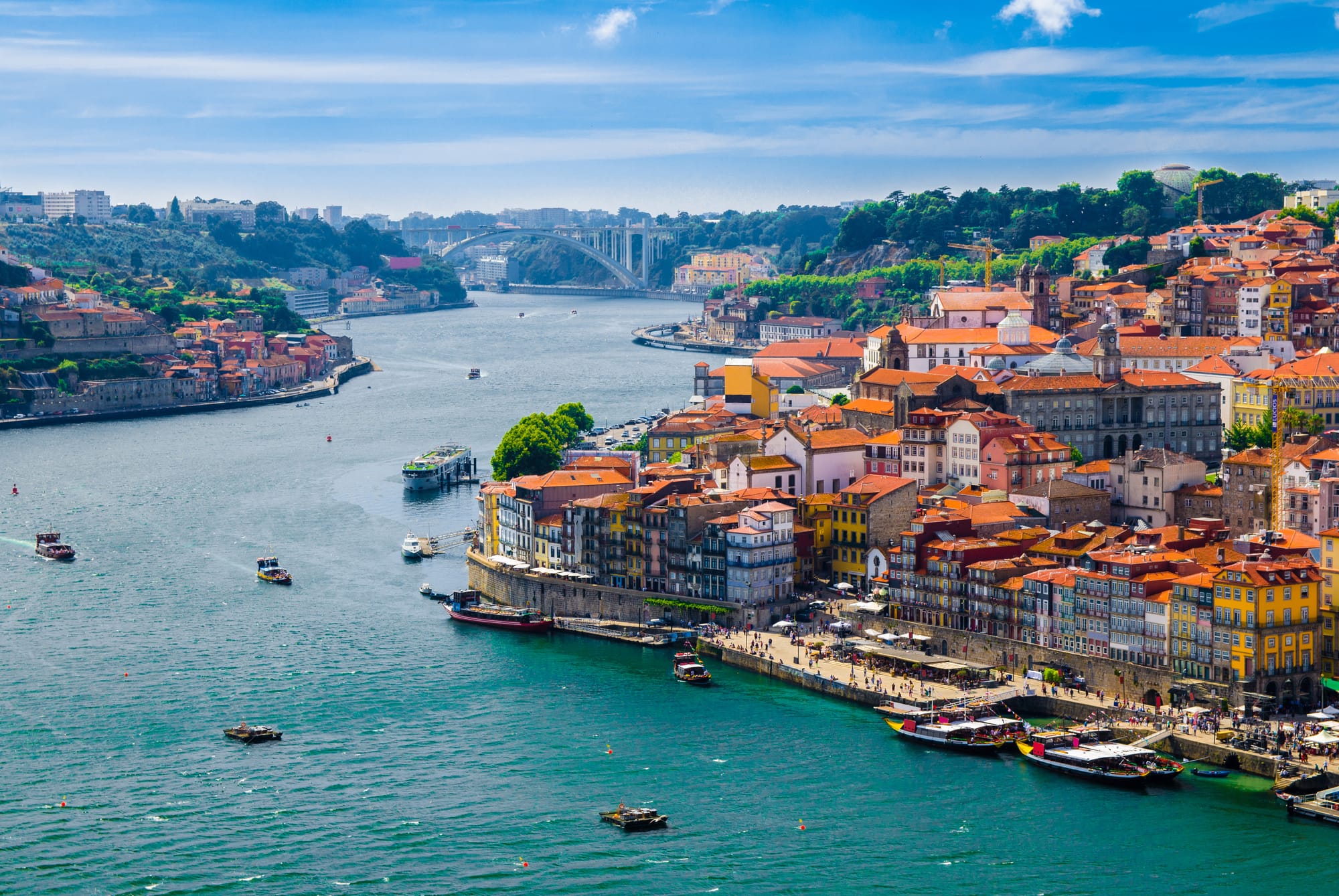
Top attractions in Porto
- Historic Centre around Ribeira Square - This city district is an absolute must-visit during your stay in Porto. It is the heart of the historic centre, which is listed as a UNESCO World Heritage Site with its old houses and plazas, the Luíz I Bridge and the Monastery of Serra do Pilar. There’s plenty to see and do here: soak up the atmosphere, visit the historic buildings, ride the funicular to the top of the city and cross the Luís I and Arrábida Bridges over the Douro River for wonderful views of Porto.
- Bolsa Palace - Originally the home of the Portuguese stock market, Bolsa Palace is a beautiful building that took 38 years to build. It is heavily inspired by Islamic architecture and sculptures, painting, Arabic calligraphy and artefacts are displayed on its walls and in all rooms of the palace.
- Lello Bookstore (Livraria Lello) - Don't leave without reading a book in the famous Lello bookstore. You will appreciate its high ceilings and its walls entirely lined with precious and antique wood. This bookstore has inspired those in the films, "Beauty and the Beast" and "Harry Potter".
- Crystal Palace Gardens - If you’re looking for greenery and a place to relax in Porto, look no further than Crystal Palace Gardens, with its domed pavilion. It’s a great place for a stroll and best of all, it has epic views of the Douro River.

- Portuguese Centre of Photography - Formerly an old prison, this museum has a collection of cameras dating back to the 19th century. Opened in 1997, it displays one of the most important photography exhibitions of its kind with many photos taken in Portugal and overseas.
Mosques in Porto
There are three mosques in Porto, making it relatively easy for Muslims to pray.
- Hazrat Hamza Mosque - Located in the heart of the city within a short walking distance of its many attractions - handy whilst sightseeing.
- Hazrat Bilal Mosque - Also located in the city centre, in close proximity to many of its most famous tourist attractions and to the Hazrat Hamza Mosque.
- Centro Cultural Islamico Mosque - This can easily be reached by a short metro ride from the centre - or you could choose to base yourself in the Heroismo area where it is located. Its metro station of the same name gives easy access to the city centre.
Halal food and restaurants in Porto
There are a few halal food establishments in Porto that are well worth visiting. Just like Lisbon, Porto is also a coastal city, which means there is a lot of seafood. But do note that most restaurants serve alcohol, with some even marinating the fish in with wine. So please check before ordering or call ahead if you want to be sure of the available options. With regards to halal restaurants in Porto, Taj Mahal serves Indian, Pakistani and Bangladeshi halal food, with vegetarian options too. The Ali Baba Kebab Haus is a chain in Portugal that’s great for on-the-go food that’s fast, but also healthy halal food. Turkish Kebab & Pizzeria is also a good halal option. The Indian restaurant D KEBAB serves mixed Indian and Turkish cuisine, renowned for the diversity of its choices and the quality of the meat. All dishes are halal and no alcohol is served.
How to get around in Porto
Even though Porto is a relatively small city and easily accessible by foot, there are plenty of options to get around on public transport with bus, tram, taxi and even a funicular if you don’t want to walk up steep hills. To make things easy and convenient, purchase an Andante card that is a prepaid card you can use to get on a bus or tram. Simply purchase a 24 hour card, which costs €7 or a 3-day pass for €15. A one-way trip by funicular costs €3.50. However, if you are planning a stay in Porto for more than two days, it is recommended to purchase the Porto Card, which costs €13 per day and can be purchased online. This will allow you to travel around the city as many times as you want and even benefit from discounts in certain restaurants and cafes.
3. Aveiro: the “Venice of Portugal”
Aveiro is a city on the west coast of Portugal, located along a lagoon called Ria de Aveiro. Called the “Venice of Portugal”, the city is appreciated for its architectural charm, its canals and its typical coloured facades, which will delight photography enthusiasts. History lovers can visit numerous cultural places like the Aveiro Museum, the Statues of the Bridges and the Aveiro Cathedral.
Top Attractions in Aveiro
- Moliceiro Rides - With the city known as the Venice of Portugal, no trip to Aveiro would be complete without a ride on a Moliceiro, a colourful and traditional type of boat unique to Aveiro.
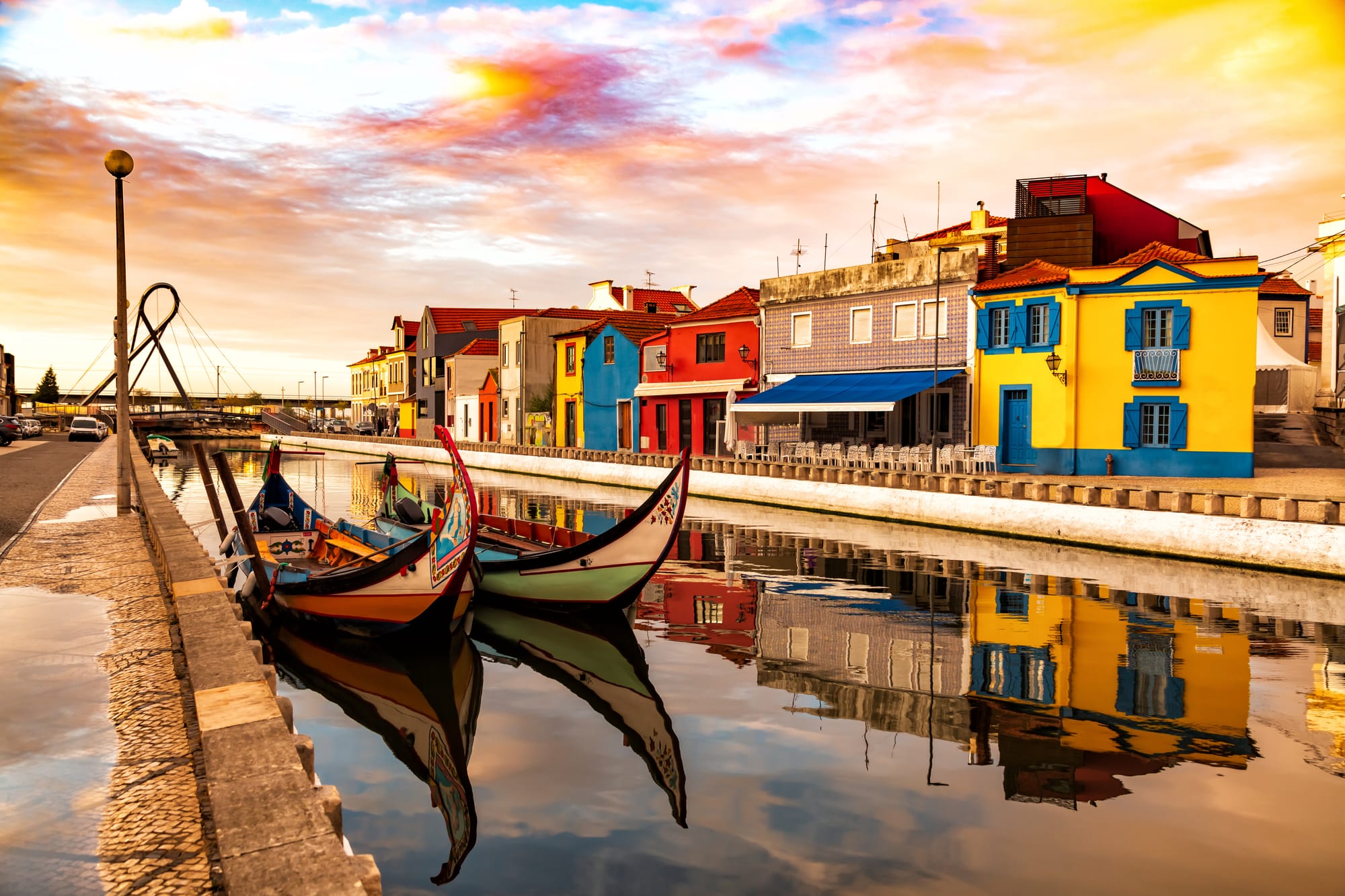
- Mercado do Peixe (Fish market) - Visiting this bustling, busy fish market is a must in Aveiro. Since the 18th century, this has been the best place to buy the freshest locally caught and sourced fish in town. The best time to come is in the early morning to catch the freshest fish from the day’s catch from the trawler boats.
- Costa Nova - A picturesque, charming fishing town in the Aveiro District, Costa Nova is famous for its magnificent sandy coastline and uniquely coloured, striped fishermens’ cottages. They were once kept to house fishing gear, but these days they now offer accommodation for short term stays in Aveiro. Enjoy tasting seafood in one of the many seafood restaurants. The beach of Costa Nova is very popular for its clean and soft sand as well as its dunes.
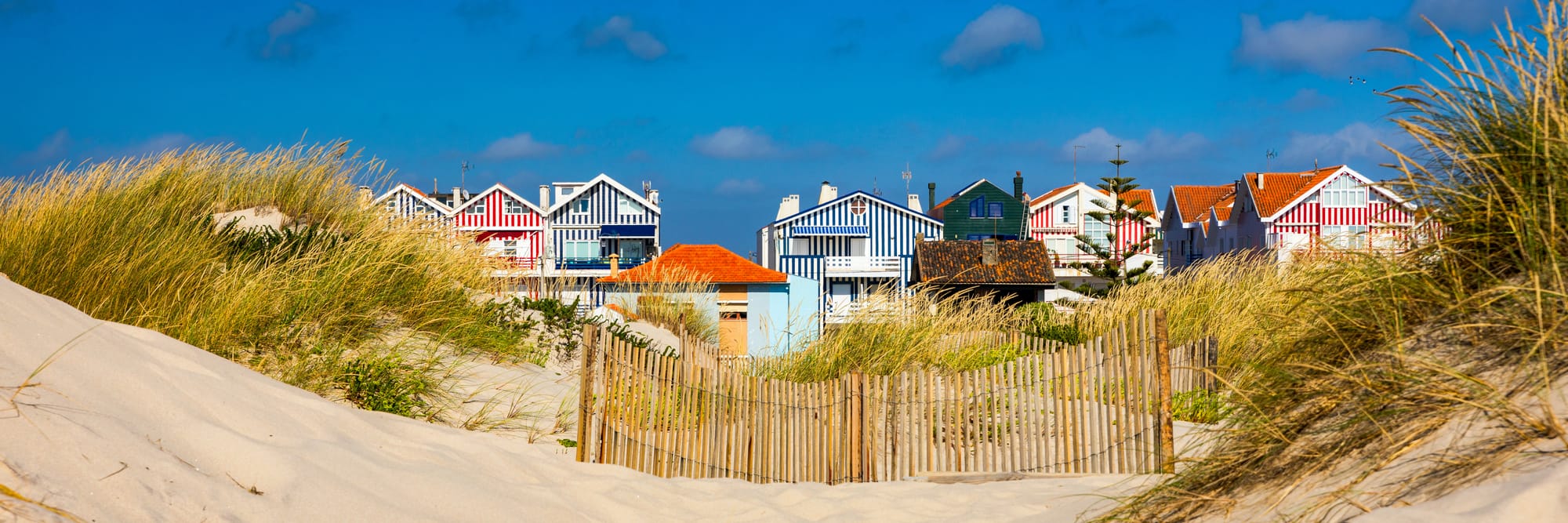
- Natural Reserve of São Jacinto Dunes - For those that love hiking and being in nature, the Natural Reserve of São Jacinto Dunes is highly recommended. It has a seven-kilometre trail which can be reached by a ferry ride from Barra Beach. The landscapes are breathtaking: white sand, dunes, pine forests and swamps. Water sports enthusiasts will also find what they are looking for here with sailing, windsurfing and water skiing. There is also a school offering windsurfing lessons.
Mosques in Aveiro
The Mosque of Aveiro is the only mosque in the city, which is located on Avenida Doutor Lourenço Peixinho, within Bazar Indiano.
Halal food and restaurants in Aveiro
If you’re self-catering then visit the Mercado do Peixe for the freshest fish, which you can cook yourself. There are also many seafood restaurants in the Costa Nova area of Aveiro to check out. The Trincaxá restaurant serves modern European and Portuguese cuisine. Succumb to their toast and their delicious bubble tea. No alcohol is served in the establishment. The King Doner Kebab serves Turkish halal fast food.
How to get around in Aveiro
The best ways to get around in Aveiro are by walking, taking a bus or if you want to take the scenic route, riding the Moliceiro boats. Given that Aveiro is quite a small city it is very walkable. There are also 13 bus routes which can take you to the beaches in Costa Nova and Barra.
4. The Algarve coast: focus on southern Portugal
Located in the far south of Portugal, the Algarve coast is renowned for its many cliffs and golden sandy beaches that line the Atlantic Ocean. The region is very popular with tourists because of the seaside resorts that are next to picturesque, whitewashed villages surrounded by olive and orange groves!
Top attractions in the Algarve
- Lagos surroundings - The Camilo Beach near Lagos, one of the best beaches in Europe, offers a breathtaking atmosphere with its rock formations, a turquoise sea and white sand. To get there, you have to go down the 200 steps of the wooden staircase. On the outskirts of Lagos, the cliffs of Ponta da Piedade are sculpted between the sea and the wind. The colour contrast is beautiful: between the ochre of the rock and the azure blue of the sea, the backdrop is perfect for unique photos.
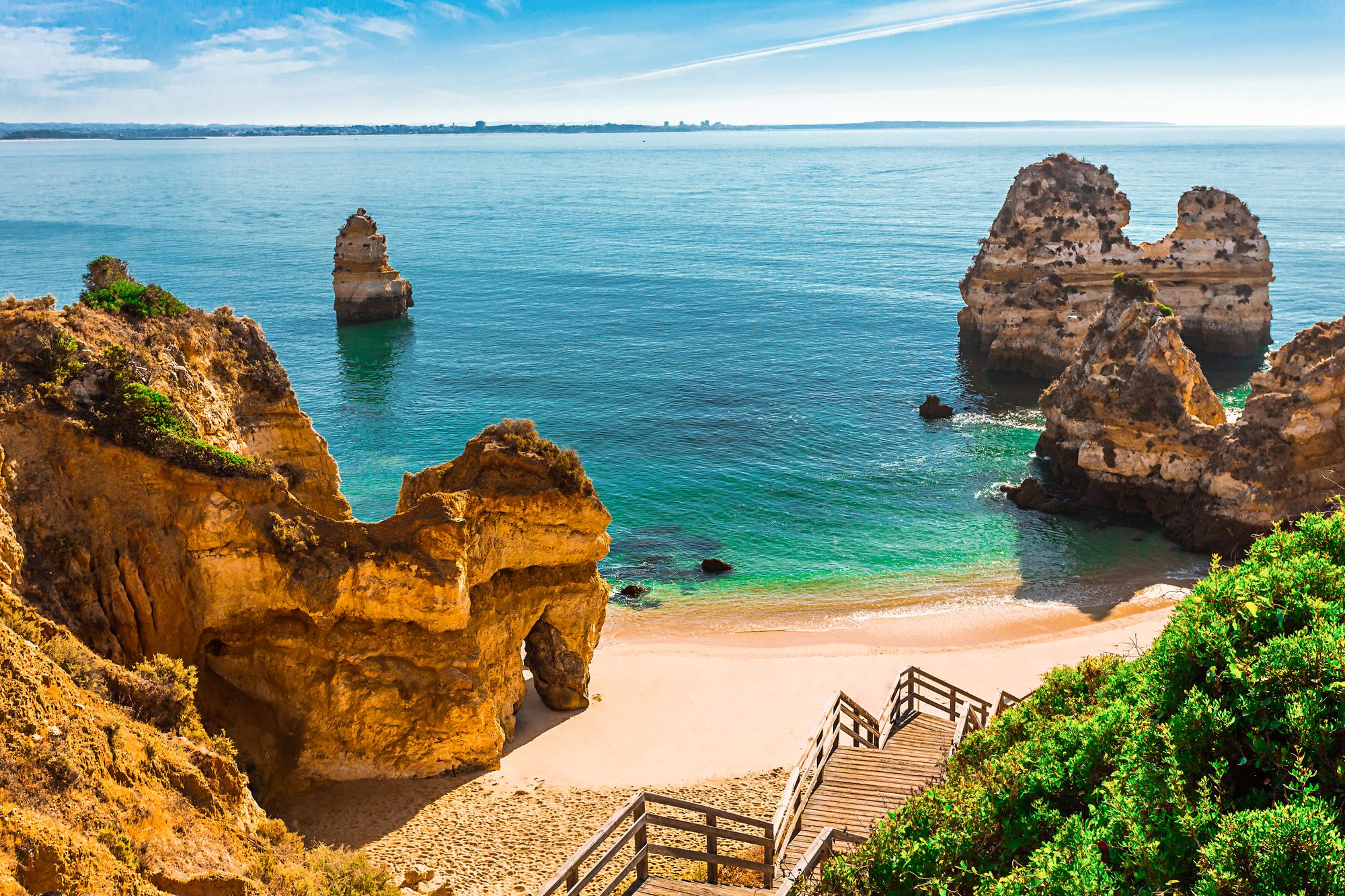
- Faro - The most popular city in the Algarve, wonderful and captivating with its beautiful squares, mediaeval quarters, interesting museums and the famous Capela dos Ossos (Chapel of Bones). Faro was the last Moorish stronghold of Portugal in the 13th century. The Old Town, surrounded by a mediaeval wall, is best discovered on foot and is a great place to stroll and check out various monuments and museums. In terms of beaches, you’re spoilt for choice as there are twenty of them to choose from.
- Albufeira - Albufeira is the biggest city in the Algarve and is popular for its golden sandy beaches, attracting tourists from all over Europe. Its white-washed Old Town is, just like Faro, cobblestoned which makes it a very pedestrian friendly place to walk around, and has plenty of restaurants and quaint little shops.

- Benagil - In this small fishing village located in the south of the Algarve, adventurers will enjoy visiting the famous Benagil caves and its unique inland beach. The sea caves have a huge open air ceiling thanks to ocean water eroding the surface for centuries, resulting in a beach inside the cave itself! The colour of the cave walls (orange, yellow and white) blends subtly with the blue of the sea. The caves are usually accessible by boat.
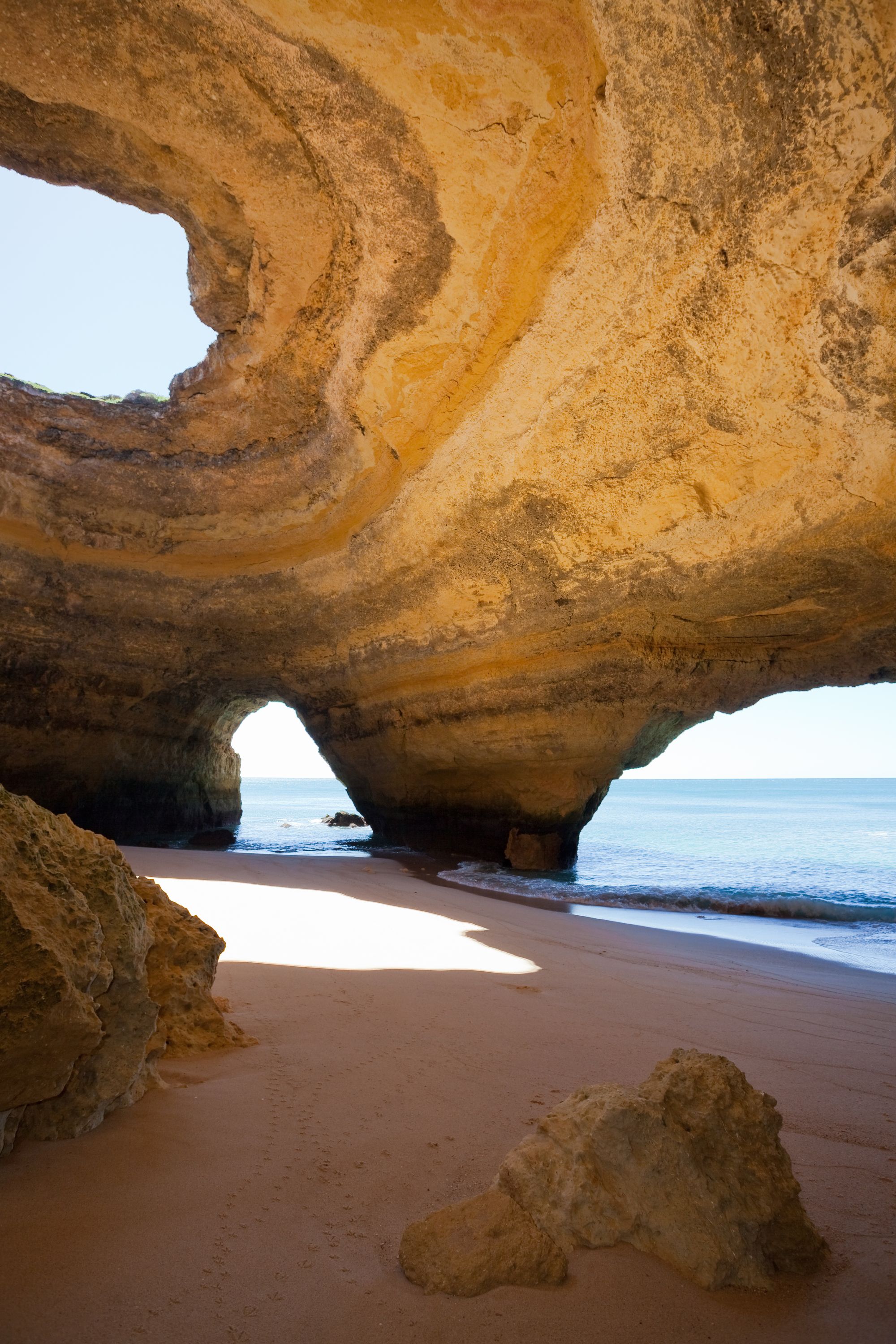
- Ria Formosa nature reserve - This bird paradise with magnificent white sandy beaches is a labyrinth of canals, islands, marshes and barrier islands that stretches for 60 km along the Algarve coast and can be explored on foot, by boat or by bike.
- The Fisherman’s Trail - This is one of the most picturesque places in the country, ideal for hiking on a 120 km route between Porto Covo and Odeceixe.
Mosques on the Algarve
There are a few mosques in the Algarve, including the Mezquita de Faro and Masjid Faro Central. Albufeira is home to a single mosque - the Mezquita de Albufeira. The Mezquita de Portimao is a small mosque and is the only one in Portimão. In Quarteira, you will find the Associação Islamica de Quarteira which is open for daily prayers.
Halal food and restaurants on the Algarve
There are a number of halal restaurants in the Algarve and most of them can be located in Albufeira. The Ranias Restaurant in Albufeira offers Mediterranean, European and Portuguese cuisine. The dishes are varied, plentiful and halal. Chutneys, also in Albufeira, serves Indian food that is all halal, with vegetarian and vegan options. In Portimão, try out Masala House, which also serves Indian food. For Turkish fast food in Praia da Rocha, Doner Kebab is worth a try and is also vegetarian-friendly.
How to get around in the Algarve
The best and easiest way to get around in the Algarve is by car, especially when travelling to villages or beaches with limited access to public transport. If you plan on renting a car, it’s easily doable via Faro Airport via several car rental companies. Taxis are also an option with apps such as Uber, or via a taxi rank outside a hotel, resort, shopping centre or train station. Trains are also available, which are cheap and will get you to major stops and destinations in the Algarve. You can buy a ticket at the station or on the train. There is also a long-distance bus service that connects not just the Algarve, but the whole of Portugal as well. But just like the trains, there is a limited network within the region with some routes having no service after 8pm.
Halal food and restaurants in Portugal
Portugal offers a world-renowned, rich and diverse, excellent gastronomy that perfectly combines Mediterranean cuisine with flavours of land and sea and reflects its cultural heritage. Outside the main cities you may not find it easy to access halal meat - and even in larger cities it will often be available in cuisines such as those from Türkiye, Lebanon, Pakistan and India, rather than in local Portuguese dishes. There are, however, plenty of seafood and fish options available - do check that no alcohol is used in preparation, before ordering. Also, vegetarian options can be found throughout the country so Muslims should be able to find plenty of tasty alternatives. Here are some of the specialties of the country:
- Francesinha - Portuguese version of the croque-monsieur, it's a sandwich made from two slices of toast topped with several meats, covered with cheese and an egg.
- Pastéis de bacalhau - Small appetizers made with potato, cod, onions and parsley.
- Caldeirada de Peixe - Stewed dishes based on fish or seafood, available as soups or stews depending on the region.

- Bacalhau à Brás - Dish made with cod, onions, matchstick fries and decorated with black olives.
The most famous desserts are the famous Pasteis de Nata (cream puffs), Bolos de Arroz (small muffins) or Pudim de Caseiro (caramel flan).

Tempted by a trip to Portugal? Halalbooking offers a wide selection of halal-friendly properties and many of them are available for booking with no deposit or with a low deposit. Use our halal-friendliness filters to find accommodation that suits you.
Discover Madeira and the Azores in our dedicated blog article: "Madeira and the Azores: discover Portugal differently!"
